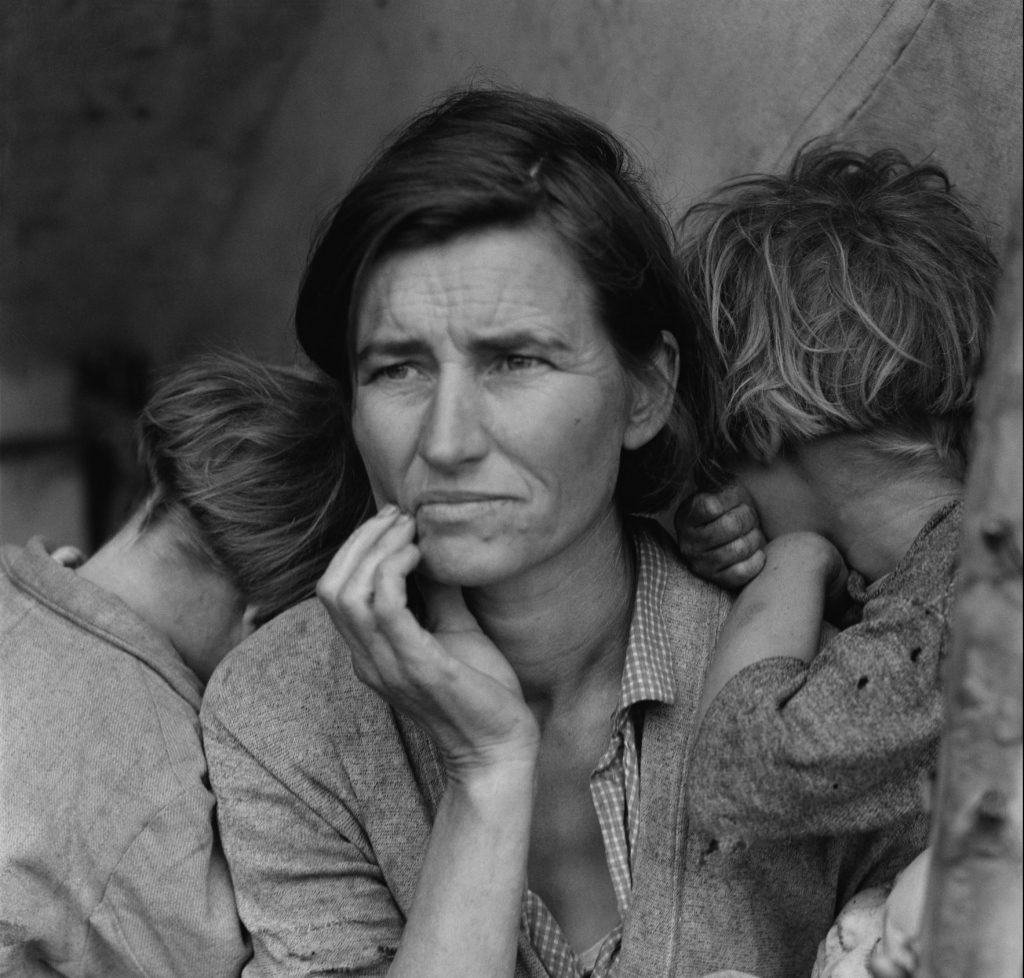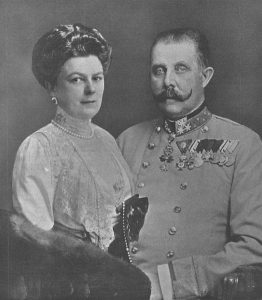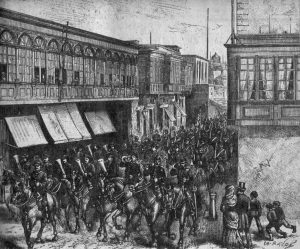What can a single image possibly say about our complex world? Of course, one picture can’t possibly capture everything. All of the tragedy and despair or all of the celebrations and joyful moments can hardly be captured in a million pictures. So, what difference can one picture really make? Documentary photographer, Dorothea Lange, set out with a simple goal in mind: to document the lives of the ordinary people in the world around her. In doing so, she inadvertently brought about drastic change through the increase of awareness of poverty and the conditions people were forced to endure. Lange influenced millions through the use of one single picture, and, that influence has and will continue for decades in the future.1
Lange found her life’s work and passion as a photographer in the 1930s, following the path of a common photographer in capturing people’s portraits and selling them to make a profit. While she enjoyed her work and was obviously very skilled, she always thought of herself as more of a historian than a true artist. As her career in portraiture continued, she improved her skills and came to open up a studio of her own in San Francisco, California. Here, she continued to perfect her craft, and she shared her talent with those among the wealthier classes of her society. It didn’t take long, however, for her to realize that her picture-taking skills could be used for much bigger, much greater, and overall, much more important things.2
In the midst of her successful portrait-focused career, the Great Depression struck and ravaged the lives of Americans far and wide. Lange, who originally, “would have thought it enough to take a picture of a man, nothing more,” quickly came to readjust her mindset upon seeing the pain in the world around her, and instead, decided that she “wanted to take a picture of a man as he stood in the world.”3 In 1933, a time in American history categorized by increasing tension and unbearable poverty in the lives of the average worker, Lange made what would come to be a life-changing decision: a drastic change in her creative mindset from elegant portraits to exposing the conditions of poverty. This single change in her life led her to become, undoubtedly, one of the most influential documentary photographers of the Great Depression.4

In May of 1935, with her newfound purpose of documenting the suffering around her, Lange became an employee of the Resettlement Administration (RA), later known as the Farm Security Administration (FSA). The goal of the RA was to bring to light the struggles of rural poverty in the country through the use of photographs. They found that sharing the conditions and hardships of life through photographs was much more impactful than any written reports, because the audience could see situations with their own eyes, which they may not have ever had the chance to see. The RA used this method of documentary photography because they recognized how powerful it could be and they needed to gain support for their projects. Lange’s job with the RA was demanding and required her to travel across the country to places that many had never heard of or even knew existed at all.5 Needless to say, she completed meaningful work and had many adventures throughout her time with the RA.

On one such adventure, on a rainy day in March of 1936, Lange had just finished another one of her photography excursions in California, and had packed up all of her equipment and supplies to begin her more than seven-hour drive home to her family. The drive started off dull and uneventful as she pushed ahead in the pouring rain. Occasionally, there were other cars and signs on the side of the road, but nothing out of the ordinary for the small San Luis Obispo County road. “PEA-PICKERS CAMP” one sign read. She considered stopping, thinking she would document more of the harsh conditions in the rural area, but instead, decided against it, knowing she still had a long trip ahead of her. While the sign and the camp became further and further behind her, they never left the forefront of her mind.
As she drove on, she thought to herself, questioning what could have been so special about that camp. It was just another pea-pickers camp, like the others she had already seen and taken pictures of. Why should she care about another one? It couldn’t possibly be that different from the ones she’d already seen. She would probably just drive in to find the same suffering and poverty she’d seen at the others. What difference would it make if she just drove past this one camp? Nobody even knew it existed anyway, so it wouldn’t make a difference, right? After getting lost in this inner argument, trying in every way possible to convince herself why she should not turn around, Lange almost unconsciously made a U-turn twenty miles past the sign and began to drive back to the camp.6
Upon reaching the camp that she had almost convinced herself to leave behind, Lange was drawn to one woman in particular. She didn’t ask for the woman’s name, or anything about her history or how she came to work at the pea-picker camp. Lange simply saw this kind of information as irrelevant to achieving her goal, which was to highlight the horrendous conditions and intense poverty of the Great Depression. While she didn’t learn much about the woman, she did learn that she was a mother of seven, living in a makeshift tent surviving mostly on frozen vegetables and small birds. The woman and Lange talked briefly, and then Lange proceeded to take a total of five pictures of the mother and several of her children, later saying, “There she sat in that lean-to tent with her children huddled around her, and seemed to know that my pictures might help her, and so she helped me. There was a sort of equality about it.” After spending a brief ten minutes at the camp, with the limited amount of information Lange had on her subjects, and a grand total of five pictures, Lange once again packed up her supplies and continued on her long trip back home.7

Lange’s intuition to turn her car around that day must have been very powerful. Deep down inside she must have known that her choice to go on or to turn around would make a profound difference in her story and in the lives of millions of those struggling around the world. That one, ten minute stop and those five pictures that Lange almost didn’t get the chance to take, later came to shape her entire career. Those pictures are the reason she is remembered to this day, the most famous being titled “Migrant Mother.” This image depicts the mother of seven that Lange met at the pea-picker camp, staring far off into the distance, seemingly lost in thought and isolated, even as she was surrounded by several of her children. Most, if not all, of Lange’s pictures had a recurring theme of separation from society, with an emphasis on the struggling classes and the pain that they had to endure on a daily basis.8 Lange’s “Migrant Mother,” however, displayed this theme so well that it became a symbol of the Great Depression as a whole. The image became an icon of the Great Depression and people in different cultures even began to replicate it to make it relevant to themselves. One picture gave the mother and children Spanish features, while still another gave them black features.9 Her work was so moving that it mirrored the isolated feelings of numerous cultures and became universally accepted and used to try and changed the way these people were being treated. Lange’s “Migrant Mother” slowly became one of the most recognizable and copied images in history.10
- Encyclopedia of the Great Depression, 2004, s.v. “Lange, Dorothea,” by Linda Gordon. ↵
- Allison McNeill et al., Great Depression and New Deal Biographies (Great Depression and the New Deal Reference Library: vol. 2: Biographies, UXL, 2003), 141-142. ↵
- David P. Peeler, Hope among Us Yet: Social Criticism and Social Solace in Depression America (Athens, Georgia: University of Georgia Press, 1987), 62. ↵
- Encyclopedia of the Great Depression, 2004, s.v. “Lange, Dorothea,” by Ed. Robert S. McElvaine. ↵
- Allison McNeill et al., Great Depression and New Deal Biographies, (Great Depression and the New Deal Reference Library: vol. 2: Biographies, UXL, 2003), 144-146. ↵
- Milton Meltzer, Dorothea Lange: A Photographer’s Life (New York, NY: Farrat, Straus & Giroux, 1978), 132-133. ↵
- Dorothea Lange, “The Assignment I’ll Never Forget: Migrant Mother,” Popular Photography February 1960, 1-2. ↵
- Melissa A. McEuen, Seeing America: Women Photographers between the Wars (Kentucky: The University Press of Kentucky, 2000), 110. ↵
- Judith Fryer Davidov, Women’s Camera Work: Self/Body/Other in American Visual Culture. (Durham, North Carolina: Duke University Press, 1998), 5-6. ↵
- Lawrence W. Levine, “The Historian and the Icon: Photography and the History of the American People in the 1930s and 1940s,” In Documenting America, 1935–1943, (Berkley: University of California Press, 1988), 16. ↵



140 comments
Madison Magaro
This was my first time reading about Lange and the pictures that she took. This article did a great job on explaining why she took the images and what was going on during the Great Depression. I have seen her images in many lectures that went over the Great Depression and the images do a great job at showing the emotion and pain that the people in the photographs are going through.
Danielle Sanchez
This article contained great images that carried the story along and was well written. Langes most successful portrait was when the Great Depression which took over the lives of many Americans world wide. This photographed the pain in the world around. Lange made a life changing decision documenting photographs of the great depression. Documenting the suffering around her gave her newfound purpose.
Tabitha Babcock
I’ve seen this picture around a lot, often on the cover of Time magazine, or in an article about “the best photographs of all time.” I’d always thought it looked very melancholy, but I never knew the story behind it or realized the cultural significance. It’s crazy that she almost passed that camp but then had the intuition to turn back around. It’s so important to document poverty because the upper class genuinely has no concept of it. I’m reminded of when Jacob Riis published pictures of the tenements and people said that he overexaggerated and sensationalized them.
Sierra Christa
I have never heard of the name Dorothea Lange but I have definitely seen her pictures. It seems that the photos she took were in every PowerPoint in high school. Her story and passion for the art of photography truly is visible through her work. She put a face and image to the Great Depression and through her work she was able to show the world just how hard it was on some families. Her photographs continue to be one of the most recognizable to this day as she captured this era beautifully.
D'vaughn Duran
Great informational piece and how it was well put together with the setup. It really grabs the attention of the reader with the time period. It showed off the rough times. Especially adding pictures to show expression. I know a little bit about the great depression but never heard about Dorthea Lange til this article. This article was very moving on her own experience.
Andrea Tapia
I loved reading this article because it not only talked about why Lange took these photos but the important meaning behind them. She didn’t even have to talk and the photos told their own story for her. Sometimes when we are taking photos we really forget about why we take them in the first place. This was for us to capture the true meaning behind the photo. As for Lange that’s all she wanted to do for millions of people to look at her work and feel as if they are there in the moment. I loved the vision she had capturing what happened during the Great Depression and how it affected poverty during that time. These photographs are not just for art, but the true beauty lies in her story. These photos showed so much emotion and pain they went through without hearing a single sound.
Olivia Gray
This is a very well written article. The Great Depression was such a traumatic time and is well represented in the pictures. The last picture is very touching. The photo resembles how mentally and physically drained the people were during this terrible time. I haven’t heard of Lange before, but it was interesting to read about how she captured these photos to show a glimpse of what it looked like during the Great Depression.
Alexandra Ballard
This was such a powerfully written story! I didn’t realize photographers such as Dorothy Lange existed during that time. The idea of documentary photography typically comes to my mind when I think of war or National Geographic. It’s very moving that she felt so obligated to capture people’s suffering. I think this type of photography is so important because it captures a feeling of a time nobody can go back to but we can almost feel all the emotions of the moment.
Veronica Lopez
Amazing article! It really shows the deepness the Great Depression had through pictures. I particularly love the way Dorothea Lange managed the camera. Not many photographers can reach the level of emotion and depth her pictures had. I also found this article informative. It showed me a new side of the Great Depression that I didn’t think I would get to see.
Andrew Molina
I thought this as a very informative article, especially for such a dark period in the US. I had never heard of her before but I do recall seeing her famous pictures. It really shows the struggles of everyone during that time, and how a strong women can be while snapping these famous pictures to show the world how they were suffering. Author did a good job describe her and how her portraits showed so much emotions and pain, all without saying a single word, great article.